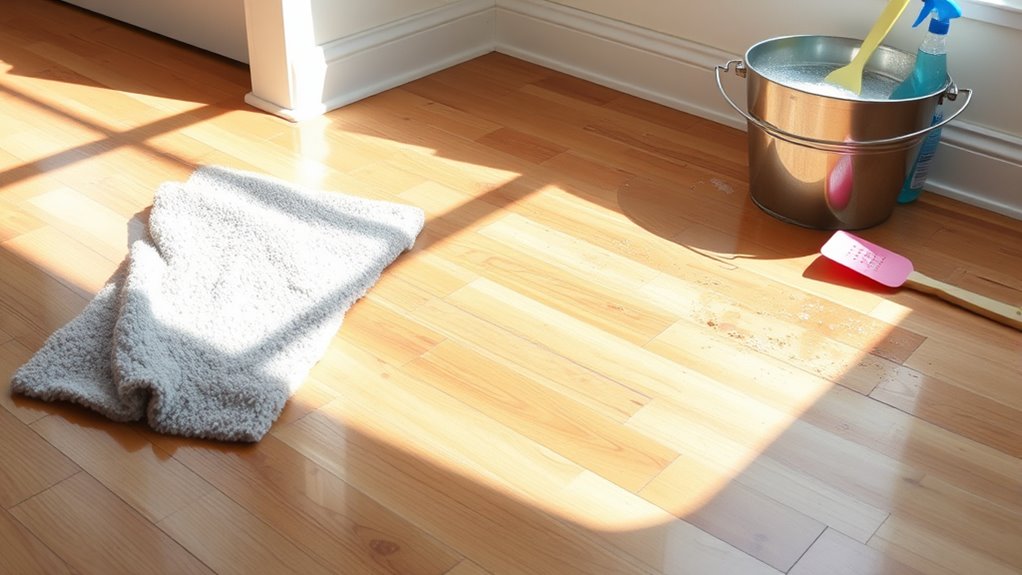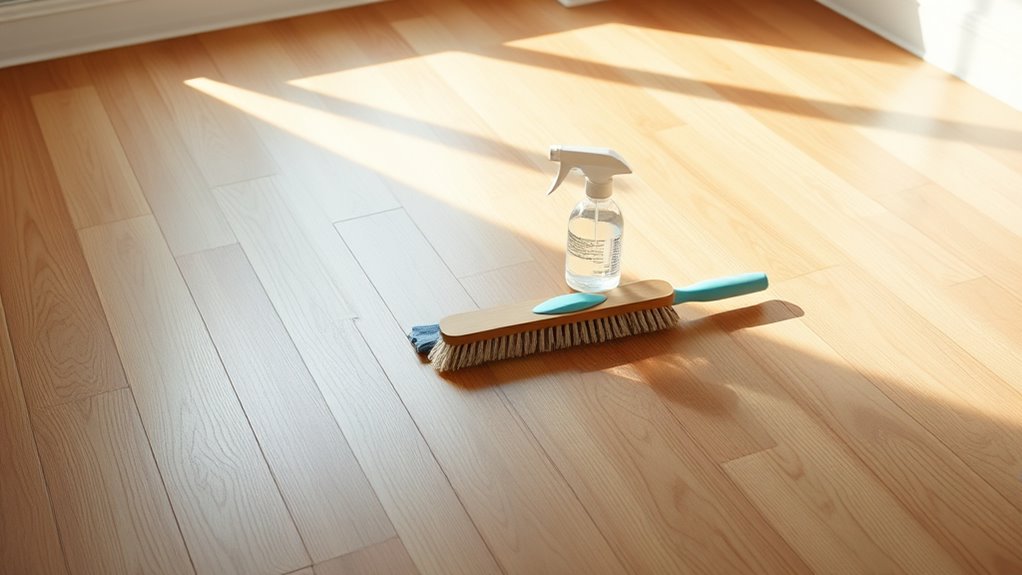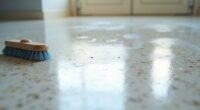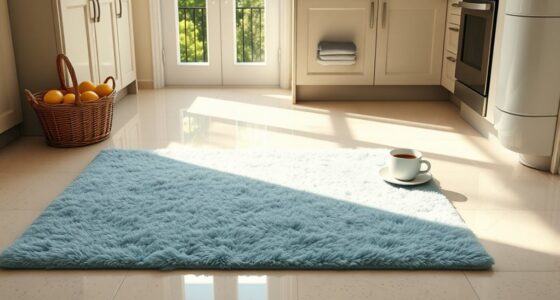Before you start scrubbing, clear the area of furniture, rugs, and decorations. Sweep or vacuum thoroughly to remove loose dirt, dust, and debris, preventing scratches and making cleaning more effective. Mix your cleaning solution according to the manufacturer’s instructions, and test it on a small hidden area to check for damage. By properly prepping the surface, you’ll guarantee a deeper clean and protect your floors—learn more about the best techniques to achieve spotless results.
Key Takeaways
- Clear the area of furniture, rugs, and decorations to ensure unobstructed access.
- Sweep or vacuum thoroughly to remove loose dirt, dust, and debris.
- Inspect the floor for any hardened debris or stains requiring pre-treatment.
- Prepare and test the cleaning solution on a small, hidden area for compatibility.
- Apply the solution evenly and allow it to sit briefly before scrubbing to loosen dirt.

Have you ever wondered why your floor doesn’t look as clean as you’d like after scrubbing? The problem often isn’t in your effort but in how you prepare the surface beforehand. Proper preparation makes all the difference, guaranteeing your scrubbing efforts are effective and your floor ends up spotless. To start, you need to understand the types of cleaning solutions available and the equipment needed to get the job done properly. Different floors and stains require different approaches, so selecting the right cleaning solutions is essential. For general dirt and grime, a mild detergent mixed with water often suffices. For grease or stubborn stains, you might need specialized solutions like degreasers or heavy-duty floor cleaners. Always check the manufacturer’s recommendations for your flooring type to avoid damage. When it comes to equipment needed, you’ll want a sturdy mop, a bucket, scrub brushes or pads, and possibly a floor scraper if there’s hardened debris. Using the correct tools allows you to loosen dirt effectively and prevents you from spreading grime around. Next, clear the floor of any objects—furniture, rugs, or decorations—so you have a free space to work in. Sweep or vacuum the area thoroughly to remove loose dirt, dust, and debris. This step is vital because scrubbing on top of loose particles can grind dirt into the surface, making it harder to clean and potentially scratching delicate floors. Once the floor is free of loose debris, prepare your cleaning solution. Follow the instructions on the product to mix the right concentration; using too much cleaner can leave residues, while too little might not be effective. Dip your mop or scrub brush into the solution, wring out excess moisture, and test a small hidden area first to make sure it doesn’t discolor or damage the surface. When applying the solution, work in sections to prevent it from drying out before you scrub. Use the equipment needed to agitate the solution and lift dirt—scrubbing with a brush or using a mop in circular motions. For stubborn spots, a floor scraper or stiff brush can help loosen and remove hardened debris. After scrubbing, rinse the floor with clean water to remove any remaining cleaning solution and dirt. This step is essential because leftover cleaning agents can leave a sticky film, attracting more dirt over time. Proper prep isn’t just about selecting the right solutions and equipment; it’s about systematically clearing, sweeping, and testing before you scrub. This way, your floor gets the thorough clean it deserves, and your scrubbing efforts become more effective and less frustrating. Additionally, understanding the contrast ratio of your cleaning products can help you choose solutions that effectively break down dirt while preserving your flooring’s finish.
Frequently Asked Questions
How Often Should I Prep My Floor Before Scrubbing?
You should prep your floor before scrubbing every time you do a deep clean, usually once a week or as needed. Proper prep guarantees better floor cleaning results and prevents dirt from spreading. Focus on sweeping or vacuuming to remove loose debris, and check for spots needing extra attention. Maintaining a consistent prep frequency helps keep your floors looking their best, making scrubbing more effective and efficient.
Can I Use a Vacuum Instead of Sweeping?
Sure, you can use a vacuum instead of sweeping, but don’t pretend it’s the same. A vacuum is great for dust mopping and picking up debris from carpets or hard floors, but a broom sweeps away stubborn dirt and larger particles better. So, if you want a thorough clean, combine both—vacuum first, then dust mop or sweep—because relying solely on a vacuum might leave you with a floor that’s only half-cleaned.
What Tools Are Best for Removing Stubborn Debris?
You should use a sturdy vacuum with appropriate attachments like a crevice tool or brush to tackle stubborn debris. These attachments help loosen and lift debris from corners and textured surfaces. Once you’ve vacuumed thoroughly, dispose of the debris properly in a trash bag or bin. This guarantees all debris is removed effectively before scrubbing, leaving your floor clean and ready for the next step.
Should I Wet the Floor Before or After Sweeping?
You should wet the floor after sweeping to maintain proper cleaning sequence. Sweeping first removes loose debris, preventing it from spreading when you add moisture. Once the floor is dry and free of debris, lightly dampen it to loosen stubborn dirt and grime. This approach helps control floor moisture, making scrubbing more effective and reducing the risk of damage. Always guarantee the floor isn’t overly wet to avoid long-term moisture issues.
Are There Different Prep Steps for Tile and Hardwood Floors?
Yes, there are different prep steps for tile and hardwood floors. For tile, focus on grout cleaning to remove dirt and mold, then rinse thoroughly. For hardwood, sweep carefully to remove debris and damp mop with a gentle cleaner. After prep, consider surface sealing for tile to protect grout, but avoid sealing hardwood. Proper prep guarantees effective cleaning and maintains your floors’ durability.
Conclusion
Remember, a clean floor starts with a good prep. Take the time to clear debris, sweep, and spot clean before scrubbing. This step makes your job easier and guarantees a thorough clean. Think of it like building a house—your prep work lays a solid foundation for everything that follows. As the saying goes, “A stitch in time saves nine.” Proper preparation now means less work later and a sparkling, refreshed floor you’ll love strolling on.









